
USS Constitution, also known as Old Ironsides, is a three-masted wooden-hulled heavy frigate of the United States Navy. She is the world's oldest commissioned naval warship still afloat. She was launched in 1797, one of six original frigates authorized for construction by the Naval Act of 1794 and the third constructed. The name "Constitution" was among ten names submitted to President George Washington by Secretary of War Timothy Pickering in March of 1795 for the frigates that were to be constructed. Joshua Humphreys designed the frigates to be the young Navy's capital ships, and so Constitution and her sister ships were larger and more heavily armed and built than standard frigates of the period. She was built at Edmund Hartt's shipyard in the North End of Boston, Massachusetts. Her first duties were to provide protection for American merchant shipping during the Quasi-War with France and to defeat the Barbary pirates in the First Barbary War.

USS United States was a wooden-hulled, three-masted heavy frigate of the United States Navy and the first of the six original frigates authorized for construction by the Naval Act of 1794. The name "United States" was among ten names submitted to President George Washington by Secretary of War Timothy Pickering in March of 1795 for the frigates that were to be constructed. Joshua Humphreys designed the frigates to be the young Navy's capital ships, and so United States and her sisters were larger and more heavily armed and built than standard frigates of the period. She was built at Humphrey's shipyard in Philadelphia, Pennsylvania and launched on 10 May 1797 and immediately began duties with the newly formed United States Navy protecting American merchant shipping during the Quasi-War with France.
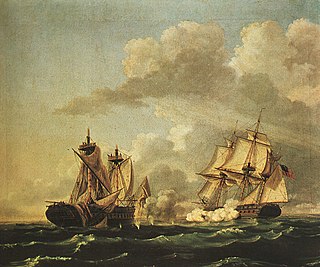
HMS Macedonian was a 38-gun fifth-rate Lively-class frigate in the Royal Navy, later captured by the USS United States during the War of 1812.
The third USS Dolphin was the brig in the United States Navy. Her plans were the basis of other brigs of that time. She was named for the aquatic mammal.
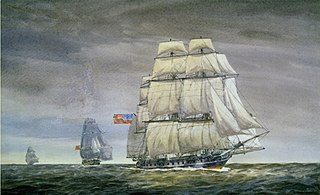
USS Adams was a 28-gun (rated) sailing frigate of the United States Navy. She was laid down in 1797 at New York City by John Jackson and William Sheffield and launched on 8 June 1799. Captain Richard Valentine Morris took command of the ship.

The third USS Delaware of the United States Navy was a 74-gun ship of the line, named for the state of Delaware.
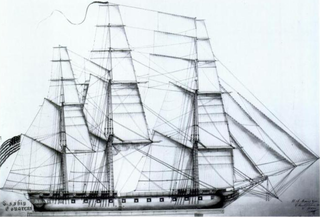
USS Congress was a nominally rated 38-gun wooden-hulled, three-masted heavy frigate of the United States Navy. James Hackett built her in Portsmouth New Hampshire and she was launched on 15 August 1799. She was one of the original six frigates whose construction the Naval Act of 1794 had authorized. The name "Congress" was among ten names submitted to President George Washington by Secretary of War Timothy Pickering in March 1795 for the frigates that were to be constructed.Joshua Humphreys designed these frigates to be the young Navy's capital ships, and so Congress and her sisters were larger and more heavily armed and built than the standard frigates of the period.
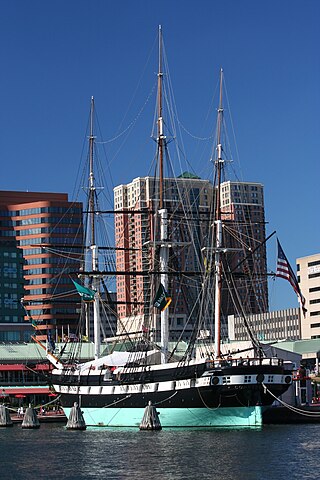
USS Constellation is a sloop-of-war, the last sail-only warship designed and built by the United States Navy. She was built at the Gosport Shipyard between 1853 and 1855 and was named for the earlier frigate of the same name that had been broken up in 1853. The sloop's primary armament was 8-inch (203 mm) shell-firing guns and four 32-pounder long guns, though she carried other guns as well, including two Parrott rifle chase guns. Constellation's career as a front-line unit was relatively short; after entering service in 1855, she served with the Mediterranean Squadron until 1858, and in 1859, she was assigned as the flagship of the Africa Squadron, where she served with the African Slave Trade Patrol. During the American Civil War (1861–1865), the ship returned to the Mediterranean to patrol for Confederate vessels. In late 1864, she returned to the United States to be decommissioned, as most of her crews' enlistments had expired. She spent the rest of the war out of service.

USS Raleigh (C-8) was a United States Navy protected cruiser of the Cincinnati class, commissioned in 1894 and in periodic service until 1919.
USS New York was a three-masted, wooden-hulled sailing frigate in the United States Navy that saw service during the Quasi-War with France.
The second USS Delaware was a ship which served in the United States Navy during Quasi-War with France.

The second USS Macedonian, was a three-masted, wooden-hulled sailing frigate of the US Navy, carrying 36 guns. Rebuilt from the keel of the first Macedonian at Gosport Navy Yard, Portsmouth, Virginia beginning in 1832, the new Macedonian was launched and placed in service in 1836, with Captain Thomas ap Catesby Jones in command.
The second USS Ontario was a three-masted, wooden-hulled sloop of war in the United States Navy, bearing 16 guns, and saw service during and following the years of the War of 1812 and in the Second Barbary War. Ontario was built by Thomas Kemp, Baltimore, Maryland, in 1813; blockaded in Chesapeake Bay through the War of 1812; and sailed from New York for the Mediterranean on 20 May 1815, Master Commandant Jesse D. Elliott in command.

The United States Congress authorized the original six frigates of the United States Navy with the Naval Act of 1794 on March 27, 1794, at a total cost of $688,888.82. These ships were built during the formative years of the United States Navy, on the recommendation of designer Joshua Humphreys for a fleet of frigates powerful enough to engage any frigates of the French or British navies, yet fast enough to evade any ship of the line.
USS Germantown was a United States Navy sloop-of-war in commission for various periods between 1847 and 1860. She saw service in the Mexican–American War in 1847–1848 and during peacetime operated in the Caribbean, in the Atlantic Ocean off Africa and South America, and in East Asia. Scuttled at the outbreak of the American Civil War in 1861, she was captured and refloated by the Confederate States of America and placed in service with the Confederate States Navy as the floating battery CSS Germantown before again being scuttled in 1862.

USS St. Louis was a sloop-of-war in the United States Navy through most of the 19th century.

USS Annapolis (PF-15) was a United States Navy Tacoma-class frigate in commission from 1944 to 1946. She was the second ship of the U.S. Navy to be named for Annapolis, Maryland. She later served in the Mexican Navy as ARM General Vicente Guerrero.
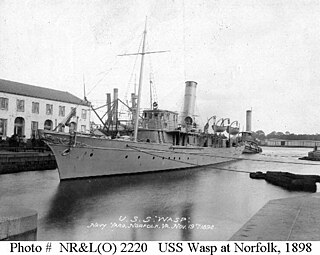
The seventh USS Wasp was the former yacht Columbia, purchased by the U.S. Navy and converted to an armed yacht serving from 1898 to 1919, with service in the Spanish–American War and World War I.

The second USS Barnegat (AVP-10), in commission from 1941 to 1946, was the lead ship of her class of small seaplane tenders built for the United States Navy just before and during World War II. She was the second U.S. Navy ship to bear that name.
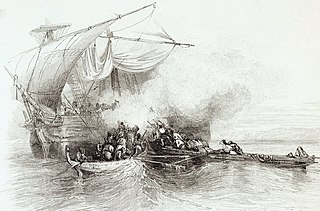
Aegean Sea anti-piracy operations began in 1825 when the United States government dispatched a squadron of ships to suppress Greek piracy in the Aegean Sea. The Greek civil wars of 1824–1825 and the decline of the Hellenic Navy made the Aegean quickly become a haven for pirates who sometimes doubled as privateers.















